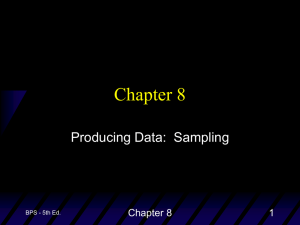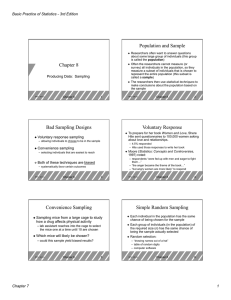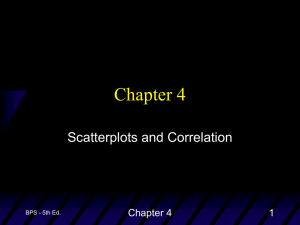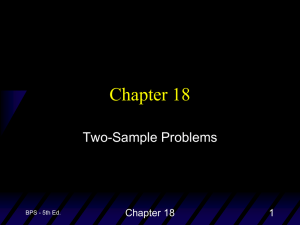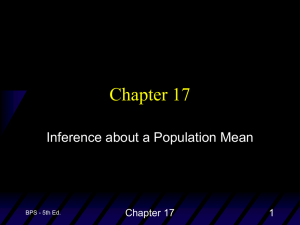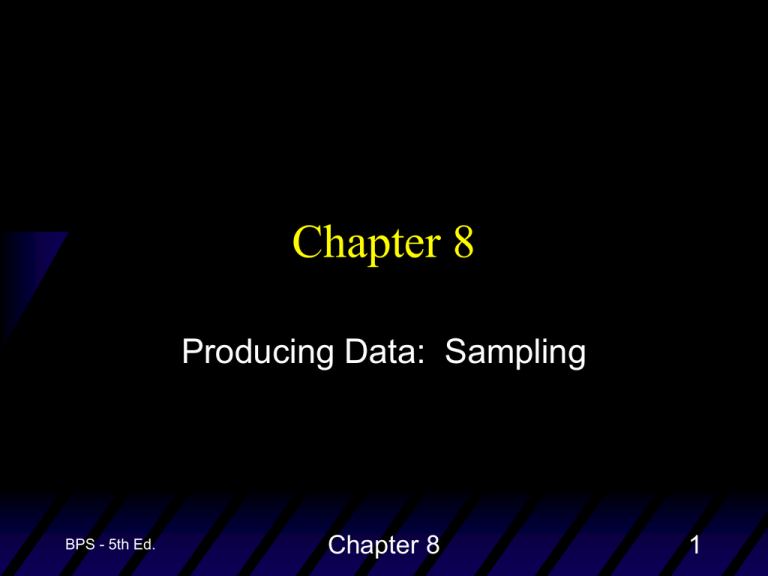
Chapter 8
Producing Data: Sampling
BPS - 5th Ed.
Chapter 8
1
Population and Sample
Researchers often want to answer questions
about some large group of individuals (this group
is called the population)
Often the researchers cannot measure (or
survey) all individuals in the population, so they
measure a subset of individuals that is chosen to
represent the entire population (this subset is
called a sample)
The researchers then use statistical techniques to
make conclusions about the population based on
the sample
BPS - 5th Ed.
Chapter 8
2
Bad Sampling Designs
Voluntary response sampling
– allowing individuals to choose to be in the sample
Convenience sampling
– selecting individuals that are easiest to reach
Both of these techniques are biased
– systematically favor certain outcomes
BPS - 5th Ed.
Chapter 8
3
Voluntary Response
To
prepare for her book Women and Love, Shere
Hite sent questionnaires to 100,000 women asking
about love, sex, and relationships.
– 4.5% responded
– Hite used those responses to write her book
Moore
(Statistics: Concepts and Controversies,
1997) noted:
– respondents “were fed up with men and eager to fight
them…”
– “the anger became the theme of the book…”
– “but angry women are more likely” to respond
BPS - 5th Ed.
Chapter 8
4
Convenience Sampling
Sampling
mice from a large cage to study
how a drug affects physical activity
– lab assistant reaches into the cage to select
the mice one at a time until 10 are chosen
Which
mice will likely be chosen?
– could this sample yield biased results?
BPS - 5th Ed.
Chapter 8
5
Simple Random Sampling
Each individual in the population has the same
chance of being chosen for the sample
Each group of individuals (in the population) of
the required size (n) has the same chance of
being the sample actually selected
Random selection:
– “drawing names out of a hat”
– table of random digits
– computer software
BPS - 5th Ed.
Chapter 8
6
Table of Random Digits
Table
B on pg. 692 of text
– each entry is equally likely to be any of the 10
digits 0 through 9
– entries are independent of each other
(knowledge of one entry gives no information about
any other entries)
– each pair of entries is equally likely to be any
of the 100 pairs 00, 01,…, 99
– each triple of entries is equally likely to be
any of the 1000 values 000, 001, …, 999
BPS - 5th Ed.
Chapter 8
7
Choosing a
Simple Random Sample (SRS)
STEP 1: Label each individual in the
population
STEP 2: Use Table B to select labels at
random
BPS - 5th Ed.
Chapter 8
8
Probability Sample
a
sample chosen by chance
must know what samples are possible and
what chance, or probability, each possible
sample has of being selected
a SRS gives each member of the
population an equal chance to be selected
BPS - 5th Ed.
Chapter 8
9
Stratified Random Sample
first
divide the population into groups of
similar individuals, called strata
second, choose a separate SRS in each
stratum
third, combine these SRSs to form the full
sample
BPS - 5th Ed.
Chapter 8
10
Stratified Random Sample
Example
Suppose a university has the following student
demographics:
Undergraduate
55%
Graduate
20%
First Professional
5%
Special
20%
A stratified random sample of 100 students could be
chosen as follows: select a SRS of 55
undergraduates, a SRS of 20 graduates, a SRS of
5 first professional students, and a SRS of 20
special students; combine these 100 students.
BPS - 5th Ed.
Chapter 8
11
Multistage Sample
several
stages of sampling are carried out
useful for large-scale sample surveys
samples at each stage may be SRSs, but
are often stratified
stages may involve other random sampling
techniques as well (cluster, systematic,
random digit dialing, …)
BPS - 5th Ed.
Chapter 8
12
Cautions about Sample Surveys
Undercoverage
– some individuals or groups in the population are left
out of the process of choosing the sample
Nonresponse
– individuals chosen for the sample cannot be contacted
or refuse to cooperate/respond
Response bias
– behavior of respondent or interviewer may lead to
inaccurate answers or measurements
Wording of questions
– confusing or leading (biased) questions; words with
different meanings
BPS - 5th Ed.
Chapter 8
13
Nonresponse
To
prepare for her book Women and Love,
Shere Hite sent questionnaires to 100,000
women asking about love, sex, and
relationships.
– 4.5% responded
– Hite used those responses to write her book
– angry women are more likely to respond
BPS - 5th Ed.
Chapter 8
14
Response Bias
A door-to-door
survey is being conducted
to determine drug use (past or present) of
members of the community. Respondents
may give socially acceptable answers
(maybe not the truth!)
For
this survey on drug use, would it
matter if a police officer is conducting the
interview? (bias from interviewer)
BPS - 5th Ed.
Chapter 8
15
Response Bias
Asking the Uninformed
Washington Post National Weekly Edition (April 10-16, 1995, p. 36)
A 1978
poll done in Cincinnati asked
people whether they “favored or
opposed repealing the 1975 Public
Affairs Act.”
– There was no such act!
– About one third of those asked expressed
an opinion about it.
BPS - 5th Ed.
Chapter 8
16
Wording of Questions
A newsletter distributed by a politician to his
constituents gave the results of a “nationwide survey
on Americans’ attitudes about a variety of
educational issues.” One of the questions asked
was, “Should your legislature adopt a policy to assist
children in failing schools to opt out of that school
and attend an alternative school--public, private, or
parochial--of the parents’ choosing?” From the
wording of this question, can you speculate on what
answer was desired? Explain.
BPS - 5th Ed.
Chapter 8
17
Wording: Deliberate Bias
“If
you found a wallet with $20 in it,
would you return the money?”
“If
you found a wallet with $20 in it,
would you do the right thing and return
the money?”
BPS - 5th Ed.
Chapter 8
18
Wording: Unintentional Bias
“I
have taught several students over the
past few years.”
– How many students do you think I have
taught?
– How many years am I referring to?
“Over
the past few days, how many
servings of fruit have you eaten?”
– How many days are you considering?
– What constitutes a serving?
BPS - 5th Ed.
Chapter 8
19
Wording: Unnecessary Complexity
“Do
you sometimes find that you have
arguments with your family members
and co-workers?”
– Arguments with family members
– Arguments with co-workers
BPS - 5th Ed.
Chapter 8
20
Wording: Ordering of Questions
“How
often do you normally go out on a
date? about ___ times a month.”
“How happy are you with life in general?”
– Strong association between these questions.
– If the ordering is reversed, then there would
be no strong association between these
questions
BPS - 5th Ed.
Chapter 8
21
Inferences about the Population
Values calculated from samples are used to
make conclusions (inferences) about unknown
values in the population
Variability
– different samples from the same population may yield
different results for a particular value of interest
– estimates from random samples will be closer to the
true values in the population if the samples are larger
– how close the estimates will likely be to the true values
can be calculated -- this is called the margin of error
BPS - 5th Ed.
Chapter 8
22

